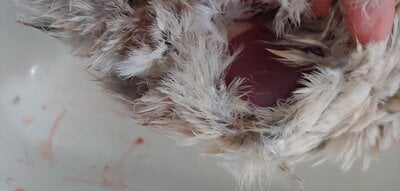Processing Quail
Before you start:
Cleanliness:
Any time you process food, cleanliness is particularly important. I start by scrubbing my sinks thoroughly, followed by a bleach rinse to completely disinfect.
Bleach rinse: 1 Tbsp bleach in 1 gallon of water
The tools you’ll need:
You don’t need any fancy tools to process quail. All I use are a sharp pair of shears, a bag to put the feathers and offal in, and sandwich bags marked with the processing date to put the finished quail into.
Dispatching the quail:
Dispatching your quail should be done as quickly and as humanely as possible. This is why you want to make certain that your shears are sharp. You want the cut to be as quick and clean as possible. If your shears aren’t sharp enough, they will still break the neck, but you may need to do a sharp tug to remove the head.
Hold the quail firmly with its wings close to its body. This will prevent splatter.
The wings will flap once the head is removed. This is normal nerve reflex. Don’t worry, the quail is dead and isn’t feeling anything at this point.
Hold the quail neck down over the drain and let the blood drain. This only takes about a minute. If you have multiple birds to process, you may want to dispatch them all before starting to process.
Skinned or plucked:
The next question that you want to ask yourself is do you want to skin the bird or pluck the bird? Skinning is far faster and easier, but the skin can add a nice flavor and help keep the meat moist during cooking.
Skinned:
If you choose to skin the bird, start by cutting the feet off at the joint.
Next, remove the wings close to the body. This will make the skinning much faster and easier.
To skin the bird, simply take a firm grip on the skin of the abdomen, and give a firm tug. This will rip the skin and give you a starting point to peel the rest off.
Most of the skin will peel off easily, but you will often end up with a stubborn part on the back near the tail. This can be removed with a strong pull.
Once the skin has been removed, it is time to remove the offal. This will be covered in the section “Whole or spatchcocked?”
Plucked:
There are two ways to pluck your quail. If you want fast, you’re going to want to scald the bird. If you want a tighter skin, you’re going to want to simply pluck. If you choose to pluck the bird, you will not remove the wings as we did for skinning.
Scalded:
Scalding is the most common method used. You will need a pot big enough to hold your bird and enough water to submerge it. Heat the water, but do not bring it to a boil. Somewhere around 160 degrees Fahrenheit is what I used. 15 seconds is all it takes to scald the bird. I keep the feet on until after the bird is scalded because they make a convenient way to hold the bird while keeping the rest submerged.
Remove the bird from the water, and you can almost rub the feathers off. Be careful not to tear the skin, however. The skin is delicate and easy to tear.
Cold plucked:
Cold plucking can be time consuming, but is worth it if you care about how the bird looks when you’re done.
This is much easier if your hands are completely dry. Gently grab a few feathers at a time and tug. They should come out fairly easily. It is important to grab only a few feathers at a time. If you grab too many, the skin will tear.
Once you have removed all of the feathers, you may need to take a torch to burn off some fine hairs that may be left.
Removing the offal:
There are two ways to remove the offal from the bird. If you want fast, spatchcocking, or removing the spine from the bird is the method for you. If you want a whole bird for presentation, you will want to use the cavity method.
Spatchcocked:
This method can be used either with or without the skin. The first step is to remove the cloaca and preen glands. Using your trusty shears, one cut can remove both.
Next, starting at the neck, cut down one side of the spine, being careful not to cut the entrails.
Repeat on the other side.
Once the spine has been removed, the offal can be easily removed with your fingers.
Rinse thoroughly to make sure that the cavity is clean.
Cavity:
This method can also be used either with or without the skin. The first step is to remove the cloaca and preen glands. Using your trusty shears, one cut can remove both.
Next, remove the neck. If you have a bird with skin on, peel the skin back and remove the neck. Leave the extra skin for a flap over the cavity.
To remove the offal, reach in through the cut that you made removing the cloaca and preen glands. You should be able to pull everything out through this hole.
Once the offal has been removed, you should be able to run water through the bird from the neck and out the cavity and vice versa. If you have small hands, you can put a finger through the neck opening as well.
Make sure the cavity is thoroughly cleaned. The lungs can be difficult to remove and may take some scraping.
Congratulations, you have learned how to process your quail and are ready to turn them into delicious meals for yourself and your family.



